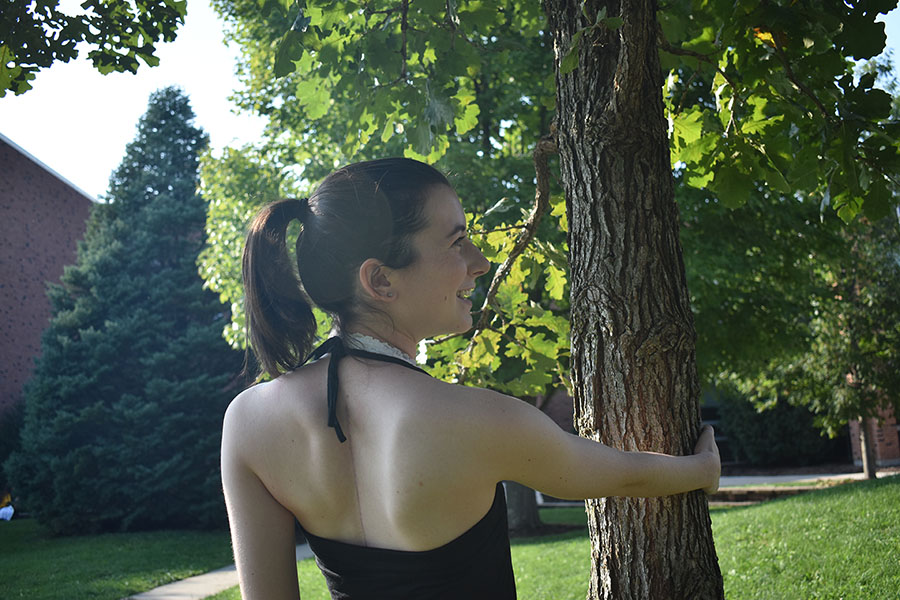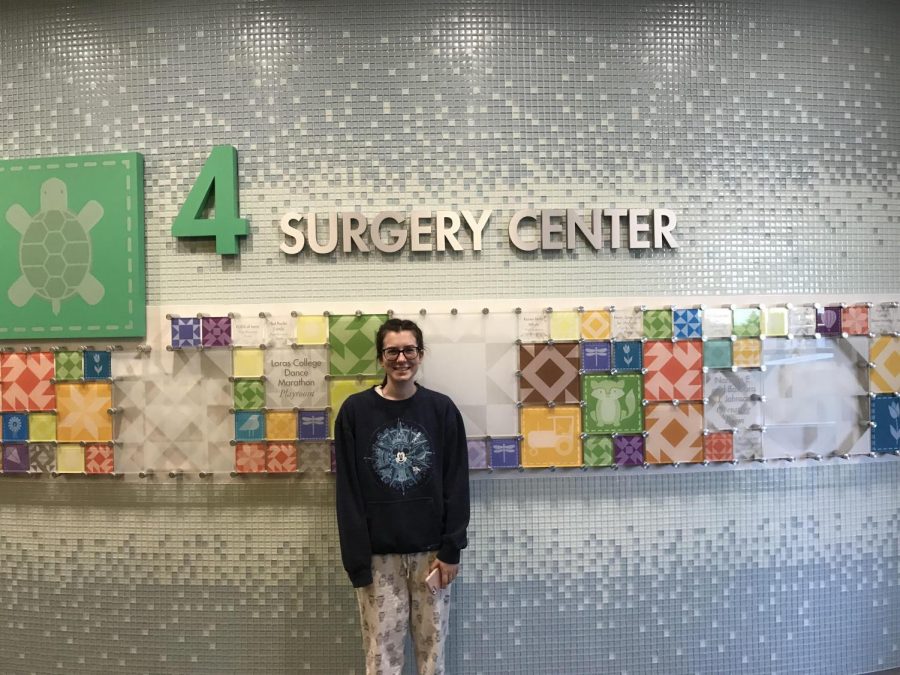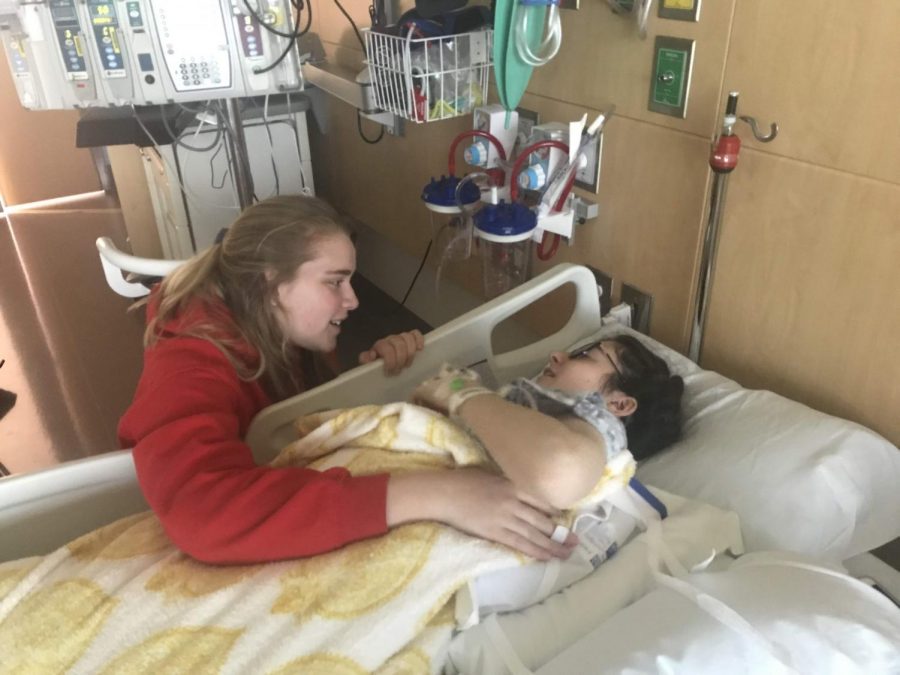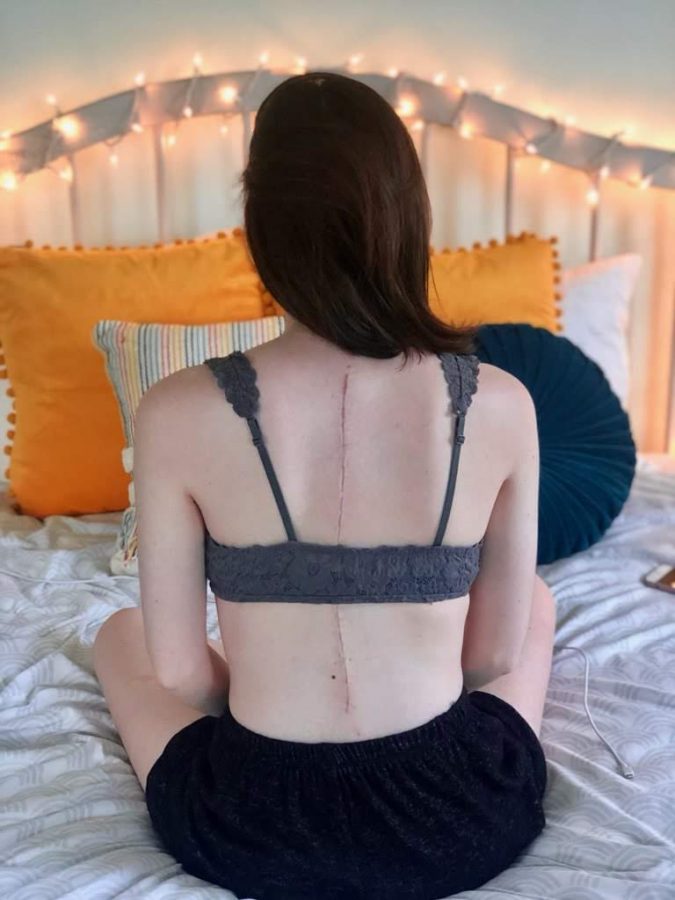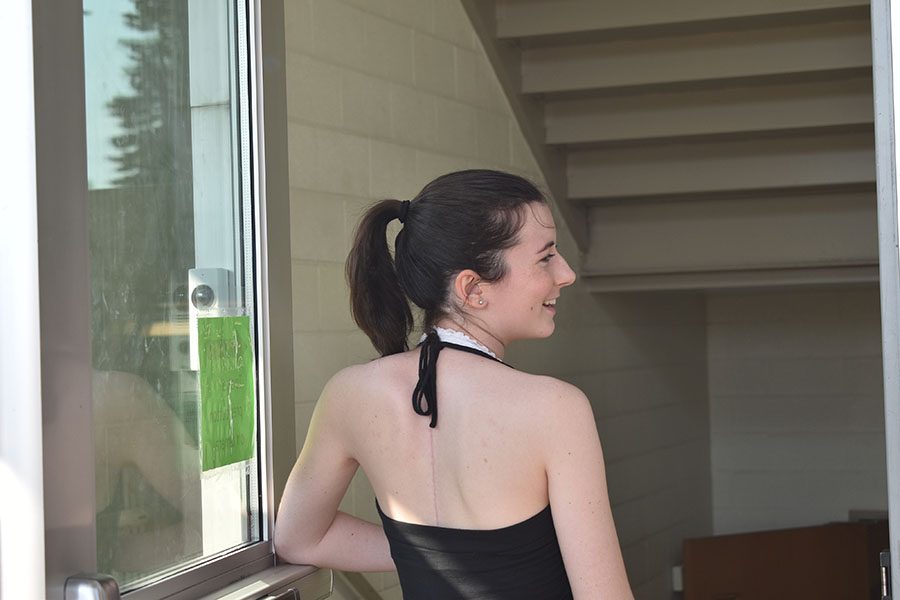Your donation will support the student journalists of West High School. Your contribution will allow us to purchase Scholarship Yearbooks, newsroom equipment and cover our annual website hosting costs.
Postoperative
In August, students returned from their summer vacations with new tans and stories of adventures. Maia DeGrazia ’20 returned from a painful summer of recovery following her spinal fusion surgery.
October 1, 2019
The diagnosis
Eight grade Maia DeGrazia ’20 poses in her eight grade formal dress, the same one her mother was tailoring when she realized her shoulders weren’t aligned.
In preparation for Maia DeGrazia’s ’20 eighth grade formal, her mother was adjusting her dress. While her mom was standing behind her, adding clear straps to the sparkly strapless top of the dress, she noticed DeGrazia’s shoulders were uneven. Her mother has minor scoliosis, as does her grandfather, so it seemed likely that DeGrazia could also have it.
They went to the doctor and at the end of eighth grade, she was diagnosed. At that point, it was minor and stable. Her spine was an “S” shape, meaning it curved at the top and the bottom. The top of her spine was curved at 38 degrees away from a straight line and the bottom was curved 22 degrees. The doctors told DeGrazia that as long as it didn’t progressively become more severe it shouldn’t be a problem.
DeGrazia returned every year for an x-ray. The third time she returned her upper curve had jumped 10 degrees. The top curve was now 55 degrees off of a straight line and the bottom was almost 30 degrees off of a straight line. This sudden jump was strange because DeGrazia had stopped growing at the time she was diagnosed. Although it was out of the blue, Maia said she sensed this change has occurred, as she was feeling more pain leading up to her final x-ray.
“I knew. I don’t know how I knew. I think part of it was I did have chronic pain every day. It hurt to sit and it hurt, just stand for long periods of time. And there were some issues surrounding that and I did notice the pain getting worse leading up to that final x-ray,” said DeGrazia.
At that point, her back had been spasming more and she had an increase in muscle pain. Going about her day had become more uncomfortable.
“It was definitely problematic because you can’t just say to your teacher at school, ‘My back hurts. Can I go lie down?’ because they don’t take you seriously because they can’t see it, so I just suffered,” DeGrazia said.
Due to the x-ray results and her chronic day-to-day pain, DeGrazia decided to get spinal fusion surgery.
DeGrazia poses at the Stead Family Children’s Hospital before her surgery.
Pre-surgery
At 17-years-old, there was no good time for DeGrazia to have the surgery, taking into account the six month recovery period. She settled on a date at the end of her junior year—May 16, 2019, with the hopes of getting it out of the way before major life events caught up to her.
“I don’t want to do it senior year. I don’t want to do before college. I don’t want to do it in college. It had to be then,” said DeGrazia of planning her surgery.
Her surgeon’s secretary had scheduled her surgery on the same date the surgeon would be out of the country. Luckily she was able to swap dates with someone who had just scheduled on May 23, 2019. This change meant she would be missing less school, but she still had to cram all her final projects and assessments into her last week.
When DeGrazia found out she would need surgery one of the first people she told was her French teacher, Theresa Juhl.
“When you have something in your future that you’re not looking forward to there’s you as always approach it with some sense of dread. And it’s really easy for that to dominate your everyday thought, and then you kind of lose perspective on what’s going on,” said Juhl.
Juhl tried to provide perspective and make DeGrazia less nervous about the upcoming procedure, while at the same time making sure she was ready to finish her assignments early.
DeGrazia’s last day of school was May 21. On May 22 she had a pre-operation appointment at the hospital where she was shocked with small pulses of electricity so doctors could create a map of her neurotransmitters. The night before her surgery, DeGrazia packed her hospital bag and a friend came over to braid her hair; due to the incision, DeGrazia wouldn’t be able to shower for a few weeks.
“I just had a fun last night, packed my hospital bag and kind of went to sleep with that feeling you get before you go on a vacation … because I knew I was going to be in the hospital for some time,” said DeGrazia.
She went to bed feeling “kind of excited, but this [other] layer of terrified.”
Claire Green ’19 visiting Maia DeGrazia in the hospital. Before her surgery Green tried to prepare DeGrazia for the experience. “I didn’t want her to feel as lost as I was. I had absolutely no idea what to expect,” Green said.
In the hospital
In spinal fusion surgery, DeGrazia had two metal rods inserted and screwed into the sides of her spine. The spine is pulled into place, which leaves some holes that are filled with cadaver bone.
DeGrazia’s surgery lasted four and a half hours and required several blood transfusions. She stayed in the hospital for 5 days.
During her stay, she had to relearn “basic human things”, as DeGrazia put it. Two days after the surgery her nurses made her walk, which DeGrazia describes as a difficult, but necessary requirement.
“You don’t want to [walk] and it hurts, but they make you do it because you have to get moving as soon as you can,” she said.
Even once she could walk, it was difficult for DeGrazia to move her neck and arms. Eating was difficult because she never felt hungry and when she did eat she had to be fed by a nurse. The combined loss of appetite and stress led DeGrazia to lose 10 lbs. The nurses also had helped her use the restroom and a physical therapist helped her move and get into a chair.
More pleasant memories DeGrazia has from the hospital are the visits from friends. She also chose to share some snapshots of her time at Stead Family Children’s Hospital on her Instagram stories to those who were trying to contact her online.
“I know that there are a lot of people at school who were thinking about me, which was super nice, and they wanted updates [but] it was getting problematic to have to get in contact with people individually,” Degrazia said.
Since she was on a lot of medication and wasn’t able to move, social media was a simpler way to update friends that were thinking of her.
Beyond staying in contact, it was also important for her to share because she didn’t want people who have scoliosis to fear surgery if it was potentially in their future.
“Because it’s such a personal surgery, so little is shared about it and I think it’s really important that people know that this is a thing [and] it’s okay to show yourself when you’re vulnerable…” DeGrazia said. “I want my social media to reflect who I am, unfortunately, this is part of it. I’d obviously prefer if I’d never had scoliosis in the first place, but I can’t deny that it’s part of who I am either. Especially with it being so impactful on my life.”
Summer
Maia DeGrazia’s sister Tess DeGrazia ’23 took this photo of her over the summer.
While her peers spent the summer with family and friends everywhere from the pool to other countries, DeGrazia was recovering, isolated and in pain. Watching everyone’s summer unfolding on social media, DeGrazia felt like she was missing out. She became more lonely and every day felt the same.
“When I was becoming more conscious and more aware of what was going on, when I was getting more bored more easily and also a little bit more depressed about having to be inside and just about the situation, was also the time when people visited me the least because it was later after my surgery,” DeGrazia said.
One visitor that kept coming back was City High graduate Claire Green ’19. Green and DeGrazia’s experience with scoliosis has several parallels. Both had an S-shaped curve and had the spinal fusion surgery performed by the same doctor the summer preceding their senior year. In a way, Green has served as look into Maia’s future, as well as proof that the pain DeGrazia still feels will come to an end.
“I’m a year ahead of her. I’m a year into her future,” Green said.
Because Green had been in DeGrazia’s place, she wanted to be there to support her.
Friends and family could see the pain, but Green knew it and could remember it when she saw DeGrazia.
“I wanted to be there and it helps to have someone who kind of knows what you’re going through there with you,” Green said.
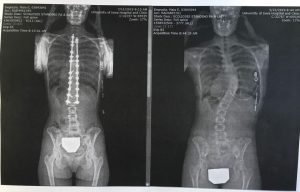
These x-rays show DeGrazia’s spine before and after the operation. DeGrazia had an S shaped curve prior to her spinal fusion surgery.
DeGrazia spent a lot of time sitting in a recliner in her family’s piano room. During the summer it served her recovering room.
“We have a grand piano [and the room] has a big picture window,” DeGrazia said. “So it’s just a beautiful little area for me to sit in and feel good because I’d be sitting a lot. And I would just sit in that chair all day.”
Her older brother Mason DeGrazia ’18 played music for her when he was home from college, which meant a lot to DeGrazia because she couldn’t play piano herself. Her parents were also very important in her recovery. Her mom slept in her room for a while after surgery because DeGrazia couldn’t turn herself over in bed.
The beginning of July was the most difficult time for DeGrazia.
“I was really, really struggling to stay happy and positive because … you’re in so much pain, you can’t imagine yourself not ever being not in pain again, like I did not remember what it felt like to just be able to sit and not be in pain, or to lay down and not be in pain or to breathe and not be in pain,” DeGrazia said.
DeGrazia continued gaining strength and mobility. She tried to walk up the driveway once a day and she went upstairs to reach her bedroom. Towards the end of the summer, DeGrazia was able to do more. Two months after her surgery she helped at her mother’s summer camp.
“I wasn’t seeing improvements day to day, but as the weeks went on, I realized I’m kind of seeing improvements week to week. And it was it was just hard because I really want instant gratification and so going about my day like not feeling like I’ve succeeded, feeling like a failure because I can’t do normal human things, like get myself a glass of water or go to the bathroom on my own was super, super demoralizing,” DeGrazia said.
Degrazia was self conscious of showing her scar when she returned to school. “I was terrified. I was worried people would say something, I was worried that people would point it out and say something mean or make fun of it,” she said.
Returning to West
DeGrazia entered her senior year feeling more mature and less concerned about highschool drama.
“I felt like I have changed a lot. Everybody else left school and they had their summer and they go back and things are relatively the same. But I left school and I had this massive life-changing event happened to me,” DeGrazia said.
She also had anxiety about returning to school. Coming back to an environment with so many people was a big change and she also didn’t know how her involvement in theatre, show choir and academics would be affected.
Since DeGrazia is in recovery she still has physical limits. She can’t carry 5-10 lbs and has to use a tote instead of a backpack until the six month mark after her surgery. She also can’t do all of the choreography in show choir. However, she can sustain breath in her singing more easily since the surgery.
She also was self-conscious of her scar, which runs at 18 inches down the center of her back. DeGrazia was worried people would point it out and make comments on it. Green was a role model for DeGrazia in showing her how to embrace her scar.
“It’s my favorite thing about myself,” Green said.
Green looked at the mark as a battle scar that showed she survived a painful and grueling experience. DeGrazia has become more comfortable with showing it as the year has progressed.
“A couple weeks into school I was feeling brave and wore a shirt that showed it a little. I was relieved and amazed to literally the point of tearing up when people came up to me and said ‘I like your outfit’. They weren’t seeing me for the scar but just as someone who was wearing a cute top. No one pointed it out, and no one said anything negative,” DeGrazia said.
In terms of pain, DeGrazia is still suffering. The first week of school “was a living hell”. Sitting in a desk and being engaged in class for hours was mentally and physically challenging. While the pain is still present, it is different from the pain she felt before the and it shows progress.
“I have no idea when I’m going to feel great or normal, but it is nice, because the pain that I did have before the surgery, the chronic pain, is gone,” said DeGrazia. “So when I feel this pain, it almost makes me feel good because it’s not the old pain and it makes it lets me know that like the old pain is gone.”

